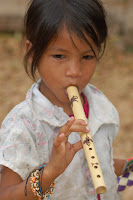Triumph and Tragedy in Cambodia
Just finishing up in Cambodia and I think it's fair to say that we've seen both the best and the worst of Cambodia's history.
 First up was a 4 day stay in Siem Reap to see the magnificent temples of Angkor including the mighty Angkor Wat, the world's largest religous building. Built over an area the size of Manhattan there are many, many temples built mainly between the 9th and 12th century AD. Some have been consumed by the jungle that surrounds them and roots from giant trees have strangled the stonework and run amok across doorways giving certain ruins a Tolkien feel to them.
First up was a 4 day stay in Siem Reap to see the magnificent temples of Angkor including the mighty Angkor Wat, the world's largest religous building. Built over an area the size of Manhattan there are many, many temples built mainly between the 9th and 12th century AD. Some have been consumed by the jungle that surrounds them and roots from giant trees have strangled the stonework and run amok across doorways giving certain ruins a Tolkien feel to them.
 First up was a 4 day stay in Siem Reap to see the magnificent temples of Angkor including the mighty Angkor Wat, the world's largest religous building. Built over an area the size of Manhattan there are many, many temples built mainly between the 9th and 12th century AD. Some have been consumed by the jungle that surrounds them and roots from giant trees have strangled the stonework and run amok across doorways giving certain ruins a Tolkien feel to them.
First up was a 4 day stay in Siem Reap to see the magnificent temples of Angkor including the mighty Angkor Wat, the world's largest religous building. Built over an area the size of Manhattan there are many, many temples built mainly between the 9th and 12th century AD. Some have been consumed by the jungle that surrounds them and roots from giant trees have strangled the stonework and run amok across doorways giving certain ruins a Tolkien feel to them. 
 Angkor Wat itself is an obvious wonder. Surrounded by a huge moat crossed by stone walkway and then by a number of huge outer walls it retains a sense of order. The main building is massive but without an overwhelming feeling because the changes in level are subtle and gradual and it is only when you climb the ridiculously steep steps to the main towers that you realise just how high up you have come. Other enormous temples litter the site, intricate stonework a feature of them all.
Angkor Wat itself is an obvious wonder. Surrounded by a huge moat crossed by stone walkway and then by a number of huge outer walls it retains a sense of order. The main building is massive but without an overwhelming feeling because the changes in level are subtle and gradual and it is only when you climb the ridiculously steep steps to the main towers that you realise just how high up you have come. Other enormous temples litter the site, intricate stonework a feature of them all.



We were lucky to see Angkor Wat for the first time at sunrise and on another day hired push bikes to explore the sites further.
Phnom Penn has provided a stark contrast to this and it is hear that we have been finding out more about Cambodia's dark past - the ghastly influence of the Khmer Rouge. Following civil war the Communist Khmer Rouge led by Pol Pot took control of the country from 1975 - 1979 when Vietnam invaded. It is estimated that 1.7 million people died as a result of the Khmer Rouge. They tried to recreate Cambodia's glorious past by relying on a peasant economy and working the rice fields which they interpreted as having been the cornerstone for the mighty Angkor empire centuries earlier.
Thus, the cities were emptied and everyone in them marched into the country to commence working the land. Professors, teachers, diplomats, foreigners and many more were arrested as posing a threat to the regime. They were often tortured and mock-confessions forced out of them before being executed. We visited S-21, a former school turned prison where inmates were tortured and the Killing Fields where the prisioners were taken for execution, usually from bludgeoning to save bullets.
Thus, the cities were emptied and everyone in them marched into the country to commence working the land. Professors, teachers, diplomats, foreigners and many more were arrested as posing a threat to the regime. They were often tortured and mock-confessions forced out of them before being executed. We visited S-21, a former school turned prison where inmates were tortured and the Killing Fields where the prisioners were taken for execution, usually from bludgeoning to save bullets.


So in an effort to take the counrty back to Year 0 the Khmer Rouge succeeded in destroying much of the heritage and ancient culture of this once hugely powerful and prosperous land. What you see now is a land in recovery. Forty percent of the population are under the age of 15. The people cling to the heritage they have left, that makes them proud. Angkor is everywhere, on the flag, in shops, postcards. The people are friendly and resilient and smiling but there is an underlying hurt from what has gone before.




We had to put this last one in or you wouldn't believe us but they really do seel deep fried spiders to eat!




0 Comments:
Post a Comment
<< Home